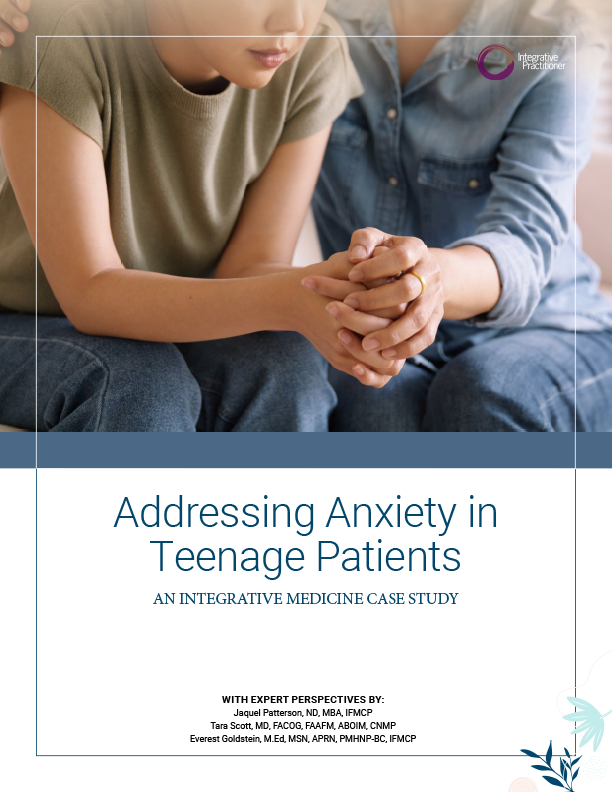Diabetes Mellitus: Patient education and current evidence
By Integrative Practitioner Staff
by Jillian L. Capodice, LAc
Background
The prevalence of diabetes mellitus (DM) has increased enormously as there were an estimated 30 million cases in 1985 versus 177 million in 2000 (1). Based on these current trends, >360 million individuals will have diabetes by the year 2030 and the increased prevalence of type 2 DM is likely due to increased obesity and reduced activity levels (1,3).
Diabetes mellitus includes a number of disorders characterized by hyperglycemia and can pathogenic factors include decreased utilization of glucose, increased glucose production, and decreased insulin secretion. These factors may broadly impact all organ systems as metabolic disorders associated with DM are frequent causes of lower extremity amputations (non-traumatic), adult blindness, renal disease, and predisposition to various cardiovascular diseases (2, 3). The main types of DM are type 1 and type 2 (see table 1) although there are many other specific types of diabetes due to such factors including genetic defects in B-cell function, genetic defects in insulin action, other disorders of the exocrine pancreas, drug-induced DM, or some infectious diseases (2).
Table 1.
| Diabetes Mellitus Type 1 | Diabetes Mellitus Type 2 |
| B-cell destruction that often leads to absolute insulin deficiency
Common causes:
|
Ranges from insulin resistance with insulin deficiency or defect in insulin secretion with insulin resistance
Common causes:
|
Diagnostic criteria according to the World Health Organization and the American Diabetes Foundation include the following:
- Symptoms of diabetes plus increased random blood glucose concentration >11.1 mmol/L or
- Fasting plasma glucose >7.0mmol/L or
- Two-hour plasma glucose >11.1 mmol/L during an oral glucose tolerance test
Conventionally, the approach to the DM patient is obviously complex as DM and complications related to CH can produce a wide variety of signs, symptoms and co-morbidities and management of glycemic control commonly necessitates a multi-disciplinary team to focus on:
- Diet/lifestyle modifications
- Exercise
- Medication
Moreover treatment of any and all associated cardiovascular and/or other conditions as well as screening and management for potential complications are imperative.
Considering that diet, lifestyle and exercise modifications are extremely important in the management of DM, the opportunity to offer integrative approaches utilizing Complementary and Alternative Medicine (CAM) and Traditional Oriental Medicine (TOM) are practical. While DM is not specifically referred to in classic textbooks of TOM, TOM practitioners commonly diagnose using various traditional or modern pattern differentials in a patient actively diagnosed with DM. Moreover, studies on various dietary supplements and acupuncture are currently underway testing some of these modalities as potential treatments for the management of DM. First I’ll briefly outline two current nutritional and dietary supplement (table 2) studies as well as some recent research on acupuncture and DM (table 3).
Table 2.
| NUTRITION AND DIETARY SUPPLEMENTS | |
| Animal Models | Human Clinical Trials |
| 1. Extract of green tea leaves partially attenuates streptozotocin-induced changes in antioxidant status and gastrointestinal functioning in rats.
Juskiewicz J et al. Nutr Res, 2008.
Comment: Green tea extract may affect GI and renal parameters in diabetic-induced rats.
Methods: Control and STZ-induced rats were supplemented with either Control, casein diet, 0.01% GT extracts or 0.2% GT extracts over 28 days.
Results: Addition of GT to the diets did not improve weight gain or rats however treatment with 0.2% GT significantly decreased diabetes-induced hypertrophy of the liver and kidneys as well as decreased maltase, saccharase and lactase in GT extract treated mice versus the STZ group.
Conclusions: GT may affect various parameters often experienced as a result of diabetic complication. |
2. Comparison of dietary conjugated linoleic acid (CLA) with safflower oil (SAF) on body composition in obese postmenopausal women with type 2 diabetes mellitus.
Norris Le et al. Am J Clin Nutr, 2009.
Comment: Comparison of CLA and SAF in obese postmenopausal women with DM type 2
Methods: Randomized, double-masked crossover study of SAF or CLA (8g/D) over 16 weeks (4 week washout). N=55
Results: CLA reduced BMI, p=0.0022 and total adipose mass, p=0.0187 in 35 evaluable women. SAF did not effect BMI but reduced trunk adipose mass, p=0.0422 and lean mass, p=0.0432. No significant differences were observed in dietary intake between the two groups.
Conclusions: Interestingly CLA and SAF demonstrated different effects on anthropometric parameters in obese post-menopausal women. |
BMI= body mass index CLA= conjugated linoleic acid DM= Diabetes mellitus SAF=safflower oil STZ= streptozotocin
Table 3.
| ACUPUNCTURE | |
| Animal Models | Human Clinical Trials |
| 3. Insulin responsiveness following EA
Higashimura Y et al, Auton Neurosci. 2009
Comment: Follow up on work that demonstrate that 10 minutes of EA to the tibialis anterior muscle increases hepatic glucose output in anesthetized rats.
Conclusion: EA to the hind limb again enhances response to glucose and is mediated by excitation of somatic afferent nerves
|
6. EA in diabetic patients for gastroparesis
Wang CP et al J Alterna Complement Med. 2008
Comment: GI motility is commonly decreased in patents with DM type 1 and 2
Methods: 23 subjects randomized to EA or sham EA. 4 treatments 2x/week. Points: ST 36. LI 4- 2hz. Measures: GCSI, fasting and postprandial blood glucose, serum gastrin, motilin.
Results: GSCI, p<0.0001. No differences in fasting blood glucose, gastrin or motilin, p=0.8 |
| 4. Improvement in GT during AD in diabetic Goto-Kakizaki (GK) rats
Ishizaki N et al. Metabolism 2009
Comment: Investigation of hypothesis that EA may increase insulin secretion and decrease plasma glucose in a spontaneously diabetic non-obese rat model
Results: EA application decreased baseline blood glucose levels in GK rats |
7. Two styles of acupuncture for treating painful diabetic neuropathy
Ahn AC et al Acupuncture Med. 2007
Comment: Diabetic neuropathy occurs in more that 30% of people with DM and TCM and Japanese acupuncture were tested to determine their effects on patients w/DM
Methods: Weekly acupuncture treatment for a total of 10 treatments. Measures: 11 point daily pain severity Likert Scale. SF-36, CBC, creatine, hemoglobin A1C, quantitative sensory tests.
Results: The results of this experiment are varied and the outcomes do seem to differ between styles although the trial was not powered to detect any meaningful differences between the points. Aspects of styles varied between the two types of acupuncture as expected and there were no significant differences in the secondary measures nor blood except for A1C which was empirically decreased in the Japanese style group both at baseline and follow up [8.8 (week 0) and 9.2 (week 10) TCM versus 6.6 (week 0) and 6.5 (week 10)]. |
| 5. Chronic e-stim in diabetic rats
Lin CC et al. Conf Proc IEEE Eng Med Biol Soc, 2005.
Comment: Original study of EA in diabetic induced rats
Points: ST 36. SP 6. K3- 4hz. Measures: BCL, NCV and TH
Results: No statistical significance on BGL in diabetic versus normal rat. p>0.05. Difference in NCV after 3 weeks of EA, p=0.8477. TH increased w/duration of hyperglycemia and EA helps attenuate TH increase, p<0.03
|
|
BGL= Blood glucose levels DM= Diabetes Mellitus EA= Electro-acupuncture
GCSI= Gastroparesis Cardinal Symptom Index GI= Gastrointestinal
NCV- nerve conduction velocity SF-36= Short-form 36
TCM= Traditional Chinese Medicine TH-tactile threshold
Conclusions
Presently, there is a huge amount of research on etiology, pathogenesis, treatments and complications related to DM. As above mentioned the main goal of therapy for a patient diagnosed with either type 1 or 2 DM is to reduce and eliminate symptoms related to the hyperglycemia, potential long-term complications, and focus on achieving a normal and healthy lifestyle. Integrative medicine utilizing CAM treatments and products may be quite valuable as many practices and agents can be utilized for a comprehensive approach to the patient. Obviously evidence still needs to be done on all potential treatments however CAM and Traditional Medicine Systems is likely a rich source of elements in the often complex and chronic treatment of DM.
References
- http://www.cdc.gov/diabetes/. Accessed August 15, 2009.
- Harrison’s Principles of Internal Medicine. 17th Edition, McGraw Hill.
- http://www2.niddk.nih.gov/. Accessed August 17, 2009
















